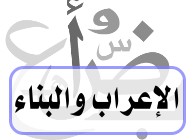Archive for 'Grammar'
More notes on gender Posted by aziza on Sep 17, 2011
To add to my previous remarks about masculine and feminine, there are some words that refer to the same thing, and they have different gender, e.g. there are two words for window in Arabic: (نافذة) which is feminine and (شباك) which is masculine, likewise there are two words for life/living (حياة) which is feminine and…
Some notes on gender Posted by aziza on Sep 15, 2011
Learning the gender of words in Arabic is often tricky to non-native speakers, as there is not an easy rule that tells us whether a word is masculine or feminine, and many rules have exceptions. One of the most useful rules is that words that end in ta’ marbouta (ة) are feminine, e.g. سميرة, أميرة…
Mabni Words الكلمات المبنية Posted by Fisal on Aug 13, 2011
In my previous post, we were introduced to the two grammatical terms of Mo’rab and Mabni. We learnt that a Mo’rab word is that which changes the harakah at its end and the Mabni word is that which is always the same with no change of harakah at its end. Most nouns and present…
Al-I’rab & Al-Binaa الإعراب و البناء Posted by Fisal on Aug 12, 2011
We already know that Arabic words are either a noun اسم , a verb فعل or a harf (particle) حرف . Today we say that all Arabic words الكلمات are either Mo’rab(ah) مُعربة or Mabni(yah) مبنية but what do these terms mean? A Mo’rab word is that word which changes the shape of its ending…
(2) Arabic Diacritics (Al-Tashkeel الـتـشـكـيـــل ) Posted by Fisal on Jul 25, 2011
The Harakaat الحركات which literally means “motions” are the short vowel marks but Tashkeel refers to other vowel or consonant diacritics.. * Fathah / ـَ / The Fatha فتحة is a small diagonal line placed above a letter and represents a short /a/. The word Fatha itself means “opening” and refers to the opening of the…
Answer of exercise on the use of ذو Posted by aziza on Jul 24, 2011
In this post, I present the answers of the exercise presented in my previous post. There are notes at the end of the post to explain the reason for the answers 1- أحب القصص ذات النهايات السعيدة. I like stories with happy endings. 2- صديقي ذو الشعر القصير اسمه محمد My short-haired friend is called…
Some exercises on the use of ذو Posted by aziza on Jul 23, 2011
In my previous post, I explained the use of ذو, and in this post, I present some exercises on the same topic. Please complete the sentences below with the right form. You need to decide on the gender, number and case of the noun the comes before it. 1- أحب القصص ———— النهايات السعيدة. I…



